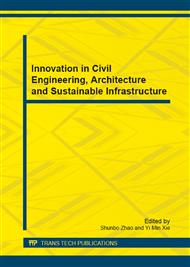p.738
p.743
p.748
p.753
p.758
p.765
p.769
p.773
p.777
Comparison Study on Crossbeam Web Cutout of Different Shapes for Orthotropic Steel Bridge Deck
Abstract:
For orthotropic steel bridge deck (OSD), principle tensile stresses near the end of joint of crossbeam web and longitudinal rib and at the edge of crossbeam cutout are dependent on the shape of crossbeam cutout to a great extent. They are results of many factors, among which bending-shearing effect and in-plane supporting effect are in-plane factors, unsymmetrical loading effect and relative longitudinal deformation effect are out-of-plane factors. Comparison study on stresses at some fatigue sensitive regions of orthotropic steel deck with six types of crossbeam web cutout indicates that the top height of cutouts determines the distance between the end of joint and the neutral axis, which affects the bending effect seriously, and the area of cutouts determines the shearing effect. When OSD system is affected by bending-shearing effect, increasing the top height decreases the principle tensile stresses near the end of joint but increases the stresses at the edge of cutout, and increasing the area increases the principle tensile stresses both near the end and at the edge of cutout. When the top height of cutouts increases, the contact area between crossbeam web drops, then the principle tensile stresses near the joint produced by in-plane supporting effect increases. When the side width of cutouts increases, the constraint effect of the crossbeam web to longitudinal rib decreases, then the principle tensile stresses near the joint produced by out-of-plane effects decreases. Generally, OSD system with stiff cutouts behaves well when affected by in-plane effects, and OSD system with flexible cutouts behaves well when affected by out-of-plane effects.
Info:
Periodical:
Pages:
758-764
Citation:
Online since:
November 2012
Authors:
Price:
Сopyright:
© 2012 Trans Tech Publications Ltd. All Rights Reserved
Share:
Citation:


